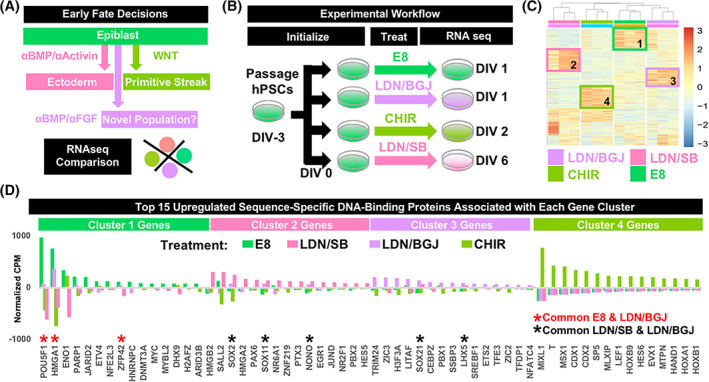FIGURE 2.

RNA sequencing of early embryonic populations identifies LDN/BGJ‐treated cultures to be a novel, early ectodermal population. A, Possible early embryonic fate decisions were identified as controls to contextualize cultures treated with 500 nM LDN and 100 nM BGJ for 24 hours. B, Three unrelated, independent hiPSC lines were maintained undifferentiated, or differentiated into either ectoderm or primitive streak using standard protocols containing 250 nM LDN and 10 μM SB435142 for 6 days or 6 μM CHIR99021 for 2 days, respectively. These controls allowed for the contextualization of cultures treated with 500 nM LDN and 100 nM BGJ for 24 hours. C, Total RNA was extracted, libraries created, and 20 M reads sequenced for each sample. Counts‐per‐million (CPM) values for each gene were normalized to generate heatmaps, demonstrating biological replicates for each treatment to cluster appropriately, and identified unique clusters of upregulated genes for each treatment group. D, CPMs for each treatment group were averaged, and GO analysis for the top 500 upregulated genes for each cluster was performed to identify sequence‐specific DNA‐binding proteins (transcription factors). The top 15 upregulated transcription factors for each group were plotted, and transcription factor overlaps indicated with asterisks. Each standard treatment group expressed germ‐layer specific transcription factors, with LDN/BGJ‐treated cultures demonstrating residual OCT4 expression, but also transcripts associated with ectoderm, such as SOX2, SOX11, LHX5, ZIC2, ZIC3, and TRIM24. BGJ, fibroblast growth factor pathway inhibitor BGJ398; CHIR, wnt pathway agonist CHIR99021; DIV, days in vitro; E8, Essential 8; hiPSCs, human induced pluripotent stem cells; GO, gene ontology; LDN, bone morphogenic protein pathway inhibitor LDN193189; SB, SB435142
